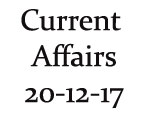-
Current Affairs 20th December 2017
Updated : 20-Dec-2017
Current Affairs 20th December 2017 - Important Points
- Niti Aayog to set up - Methanol Economy Fund
- Lok Sabha passed the Central Road Fund (Amendment) Bill, 2017 on - 19th December 2017
- International Human Solidarity Day 2017 observed across the world on - 20th December 2017
- India signs US$ 125 million worth financing agreement with World Bank on -19th December 2017
- 2nd phase of joint oceanographic survey completed by - India and Sri Lanka
Current Affairs 20th December 2017 - Details
Niti Aayog to set up - Methanol Economy Fund
Government’s think-tank Niti Aayog is thinking to set up a Methanol Economy Fund with a collection of Rs 4,000-5,000 crore. It focuses to promote manufacturing and utilization of the clean fuel with this fund.
The Niti Aayog is conscious to produce the fuel by transforming high ash content coal into methanol and such a plant is probably to be set up by Coasubstitutel India.
Niti Aayog is projecting to move a Cabinet note on the methanol economy and soon it will set up manufacturing plants.
By the end of December, it is also projecting to propose a roadmap to attain its goal of increasing the penetration of Methanol as an alternative fuel to petrol and diesel.
Objective of Methanol Economy Fund- Methanol Economy Fund will be used to promote the utilization of methanol fuel, which is safer, cheaper, and pollution free.
- Methanol manufacturing plants will be set up using coal and stranded gas assets. In India methanol can be manufactured at Rs 16-21 per liter. It is supposed to be commissioned in the coming 3-4 years.
Benefits of Methanol
- Methanol can be utilized as a transportation fuel, energy forming fuel and cooking fuel.
- It could play a mega role in bringing down India’s oil import bill by an approximated 20 percent over the coming few years.
- Using methanol as a transportation fuel would need minimal changes in the vehicles, unlike CNG.
- China is the world’s largest manufacturer of methanol.
Aayog's Future Plan - The Aayog is also working on transforming certain diesel-powered rail engines to work on methanol. Ideas are in progress to make confident that ships and boats in the inland waterways enterprises are also run on methanol.
- The Aayog is also in talks with some automobile organizations such as Tata and Volvo to manufacture buses running on methanol.
Lok Sabha passed the Central Road Fund (Amendment) Bill, 2017 on - 19th December 2017
The Lok Sabha on 19th December 2017 passed the Central Road Fund (Amendment) Bill, 2017. The Bill looks forward to amend the Central Road Fund Act, 2000. The bill was launched in the Lok Sabha on 24th July 2017.
According to the Central Road Fund Act, 2000, the cess levied and gathered on high speed petrol and diesel is dispersed for development of rural roads, railways, national highways, state roads and border area roads.Important Highlights
- The Central Road Fund (Amendment) Bill, 2017 looks forward to allocate 2.5% of the funds gathered to accelerate the development and maintenance of national waterways by decreasing the equal percentage from the portion of national highways.
- The Bill is focused at tentatively collecting about Rs 2300 crore earnings for national waterways.
Need to amend the Central Road Fund Act, 2000
- National Waterways has issued logistically efficient, cost effective, and environment friendly of transport mode.
- Its evolution as a supplementary mode will authorize diversion of traffic from the over-crowded roads and railways.
- In the past year, with the validation of the National Waterways Act, 2016, the total number of national waterways summed out to be 111.
- However, infrastructure such as jetties, navigational channels and terminals continues to be problems for better shipping and commercial navigation.
- In order to expand national waterways with modern infrastructure, sustainable source of funding is required as a budgetary support as funds from multilateral institutions are insufficient.
- One of the sustainable sources of collection for the development of waterways is to earmark definite percent of cess levied and gathered on high-speed diesel and petrol under the Central Road Fund Act, 2000.
International Human Solidarity Day 2017 observed across the world on - 20th December 2017
The International Human Solidarity Day was noticed across the world on 20th December 2017.
In the Millennium Declaration, solidarity is recognized as one of the fundamental values of international relations in the 21 Century, wherein those who benefit least deserve aid from those who benefit most.
The Day focuses to raise public awareness of the significance of solidarity and encourages discuss on the ways to enhance solidarity for the achievement of the Sustainable Development objectives including poverty eradication.Did you know?
- The UN General Assembly started the World Solidarity Fund on 20th December 2002 as a trust fund of the UN Development Program. Its aim was to eliminate poverty and encourage human and social development in developing nations.
- Later on 22nd December 2005, the General Assembly recognized solidarity as one of the fundamental and universal values via its resolution 60/209. According to the resolution, solidarity should basic relations between peoples in the 21st century.
- Thus, the assembly also finalized to proclaim 20th December of every year as the International Human Solidarity Day.
India signs US$ 125 million worth financing agreement with World Bank on -19th December 2017
India on 19th December 2017 signed a financing accordance worth US$ 125 million with the World Bank for ‘Skills Strengthening for Industrial Value Enhancement Operation (Strive) Assignment”.
The accordance for the IDA credit was signed by the Government of India with the World Bank in the New Delhi.
While Sameer Kumar Khare, the Joint Secretary in the Department of Economic Affairs, Ministry of Finance signed the deal on behalf of the Union Government, Hisham Abdo, the Acting Country Director of World Bank (India) signed on behalf of the World Bank.
Key Objective- The main aim of the operation is to upgrade access to quality and market-driven vocational training and apprenticeships.
- The final areas for the project include:
- Enhance Performance of Industrial Training Institutes.
- Enlarge Capacities of State Government to Support Industrial Training Institutes and
- Apprenticeship Training.
- Enhance Teaching and Learning.
- Improved and Broadened Apprenticeship Training.
2nd phase of joint oceanographic survey completed by - India and Sri Lanka
The Indian Navy in collaboration with the Sri Lankan navy completed the second phase of the joint oceanographic survey conducted off the South Western Coast of Sri Lanka successfully. The survey was initiated with the arrival of the Indian Naval Ship Sutlej in Sri Lanka on 26th October 2017.
The survey charts were handed over by the Indian side to the Commander of the Sri Lankan Navy on 19th December 2017. The survey extended to a depth contour of 200 m from the coastline which is ranging from Colombo to Galle.
Main Objective behind this Survey
- The main aim to launch the joint oceanographic survey was to update all the navigational charts, covering the waters of southern Sri Lanka with the latest hydrographic data.
- It is also aiming to bolster cooperation between both the countries in the field of hydrography.
- The exercise also provides an opportunity for both the naval sides to learn from each other and to build on the already existing high level of compatibility between these two nations.
Important Highlights
- The move is expected to increase the navigational safety level of all ships visiting Sri Lanka.
- Thus, it will be benefitting the international shipping traffic passing through the southern coast of Sri Lanka and in turn pave the way for the blue economy development.
More about the joint oceanographic survey
- The Indian Navy and Sri Lanka Navy conducted the first phase of the survey betweeb 30th March and 11th May 2017.
- The first survey task was undertaken by Indian Naval ship INS Darshak, which is an indigenously designed and constructed vessel, fitted with the latest state of the art survey equipment.
- The joint survey task also included the imparting of extensive training to the Sri Lankan Navy personnel who were embarked onboard the ship to help in capacity building of Sri Lankan Navy’s Hydrographic Department.
- The third phase is expected to be undertaken in next year only i.e 2018.














